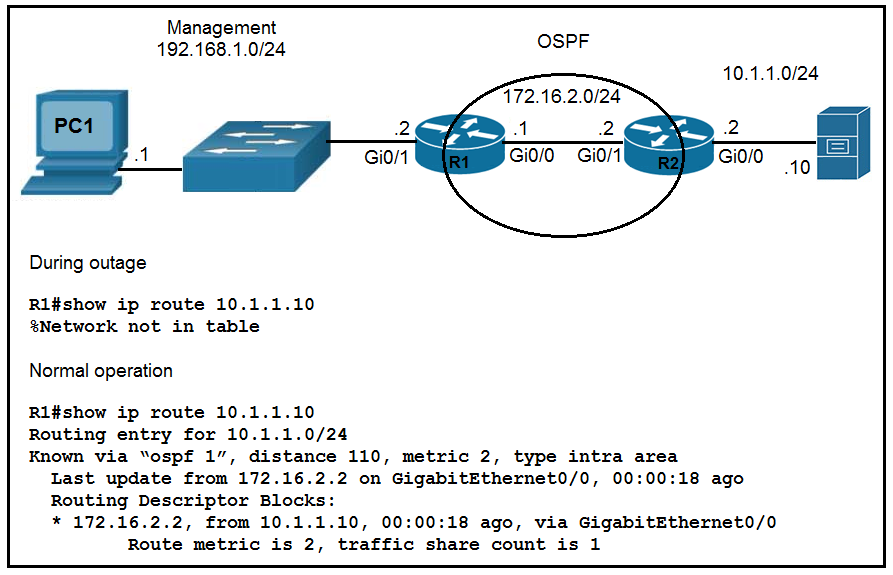
Refer to the exhibit. Which route must be configured on R1 so that OSPF routing is used when OSPF is up, but the server is still reachable when OSPF goes down?

Refer to the exhibit. Which route must be configured on R1 so that OSPF routing is used when OSPF is up, but the server is still reachable when OSPF goes down?
In this scenario, we aim to maintain reachability to the server at 10.1.1.10 when OSPF is down by configuring a floating static route. The primary route through OSPF has an Administrative Distance (AD) of 110. Therefore, a floating static route should have an AD higher than 110 to be used as a backup when OSPF fails. The route configuration 'ip route 10.1.1.10 255.255.255.255 gi0/0 125' meets this requirement. It specifies a host route to the server using the interface Gi0/0 with an AD of 125, ensuring it only takes over when OSPF is unavailable. This setup prevents the static route from interfering with the primary OSPF route during normal operation.
Answer C is wrong because it uses the wrong interface id
the interface used is the R1 exit interface. so A is correct.
Answer is A. At a glance, B has a lower manually set AD of 100. C command is wrong anyway, if you want to use the interface name instead of the next hop, you use the local router's interface which is R1's g0/0. G0/1 is the next hop to R2. D has a lower AD than 110. A has the correct command with a static host route directly to the server, a /32 subnet (host route), the local router's exit interface of g0/0, and a higher manually set AD of 125.
why is it 255.255.255.255 when the network is /24? Isnt that 255.255.255.0?
When you are using a host route or specific route. You can use the 255.255.255.255 /32. You use /24 if you are pertaining to a network route.
Route to one host is called host route,
how it's via g0/0, it should be g0/1.
Answer is C because we need to configure a floating static route. Cannot use A because that will configure a static route as OSPF does not have a entry for 10.1.1.10 only the network 10.1.1.0/24. In order for a static route to become a floating static route we need the AD to be higher than the OSPF routing protocol so it will not be put into the routing table. If you configure A you will create a static route for 10.1.1.10 in your routing table which is wrong.
10.1.1.0 /24 is reachable via ospf -> known via ospf 1 Only the server needs to be reachable if ospf 1 should go down So A
By configuring a static address to a /32 address you would create an entry in the routing table. When the router tries to route to the server network it will look for the longest matching prefix which would be the /32 (statically configured route). So it would by pass OSPF because the OSPF network is /24. Although C isn't right either since the interface is incorrect.
I mean server not server network.
Looking back while A is not the right answer it is the best answer.
como vas a salir por la interfaz g0/0, si el proximo salto es g0/1 c es correcta
A is correct the Administrative Distance of the floating static route must be greater than the primary route
shouldn't next hop be 0/1 of R2 ?
I think you're right because the next hop is G0/1. The answer should be C instead of A.
this demonic detail answers the question: gi0/0 this is teh interface towards the fateful server 1. the ip route syntax is destination + netmask + next hop. the latter can be replaced bythe interfaceif you want to reach a destination in a more direct manner
next hop can be specified in 2 ways: - IP address: must use IP of the next hop router - Interface: must use local interface connected to the next hop router
D is also correct but interface is mostly preferred and reliable. so A is correct
A HAS A HIGHER AD THAN D
On R1 Next hop is G0/1. The answer should be C instead of A.
i think you're right but the trick with mask